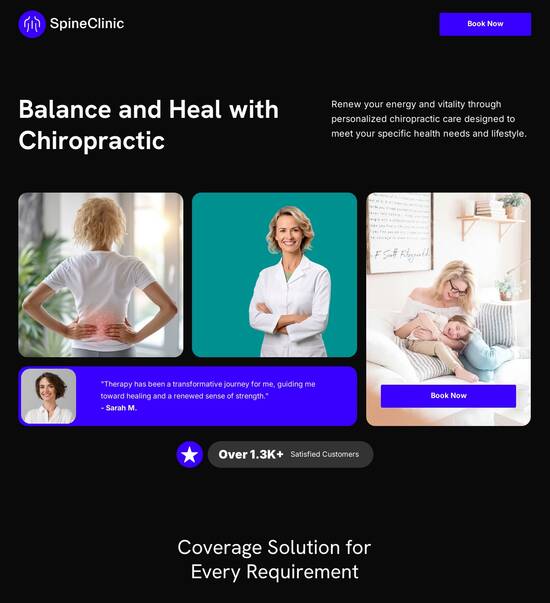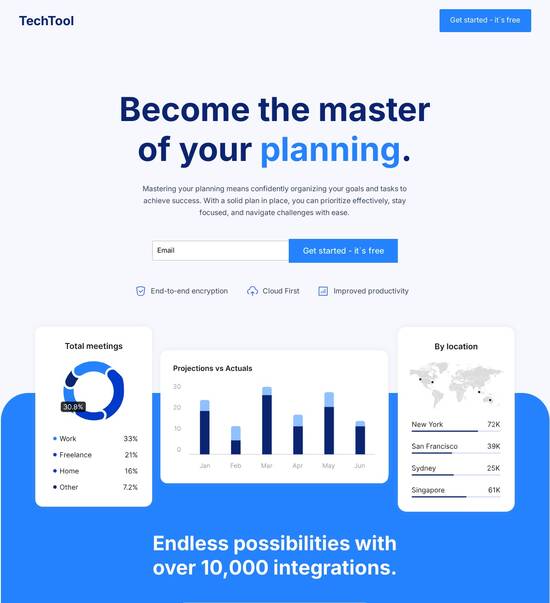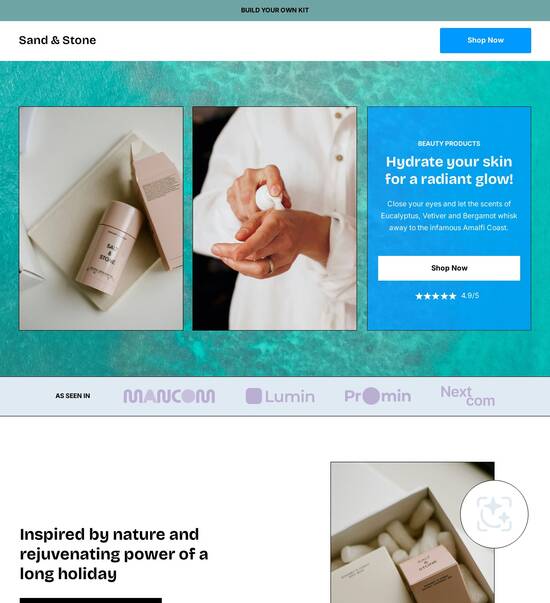
Vintage landing page templates
Use TemplateAbout template
Master the art of web design with vintage landing page templates. Transform your business today!
Recommended templates

Easy to build without coding
With the intuitive drag-and-drop builder, anyone on your team can create high-converting pages without any knowledge of code or design. Make enhancements to your landing page with custom widgets using Javascript, HTML/CSS, or third-party scripts.

Multiple layouts for any industry and goal
Select from 500+ landing page layouts built to boost conversions across industry-specific scenarios. Customize them by adjusting fonts, adding images, and generating on-brand content with the AI assistant. Quickly scale with Instablocks® and Global Blocks that you can save, reuse, and update globally.

Loads fast and looks polished on any device
Every template is responsive, which means they present professionally on any device and load blazingly fast with our Thor Render Engine. You can also power them up with Google AMP technology to deliver an unparalleled mobile experience and drive higher conversions.

Robust analytics & experimentation
Get real-time updates and reporting across all your devices, showing the number of visitors, conversions, cost-per-visitor, and cost-per-lead. Launch AI-powered experiments, run A/B tests, and use heatmaps to analyze user behavior, then optimize your landing page to maximize conversions.







Easy to build without coding
With the intuitive drag-and-drop builder, anyone on your team can create high-converting pages without any knowledge of code or design. Make enhancements to your landing page with custom widgets using Javascript, HTML/CSS, or third-party scripts.
Multiple layouts for any industry and goal
Select from 500+ landing page layouts built to boost conversions across industry-specific scenarios. Customize them by adjusting fonts, adding images, and generating on-brand content with the AI assistant. Quickly scale with Instablocks® and Global Blocks that you can save, reuse, and update globally.
Loads fast and looks polished on any device
Every template is responsive, which means they present professionally on any device and load blazingly fast with our Thor Render Engine.
Robust analytics & experimentation
Get real-time updates and reporting across all your devices, showing the number of visitors, conversions, cost-per-visitor, and cost-per-lead. Launch AI-powered experiments, run A/B tests, and use heatmaps to analyze user behavior, then optimize your landing page to maximize conversions.
All the features you need to build lead-generating landing pages
Explore more featuresLearn how to build top-performing landing pages for any goal
FAQs
Leading the way in building high-performing landing pages





Creating Effective Landing Pages with Instapage's Powerful Features
Utilizing Instapage's unique capabilities, marketers can significantly enhance their digital marketing efforts through high-converting landing pages. This guide delves into the essential steps for utilizing Instapage as the most effective landing page and conversion rate optimization (CRO) platform available. Understanding how to leverage its features can dramatically improve your campaign results and ROI.
Step 1: Choosing the Right Template
Instapage offers more than 100 pre-designed templates tailored for various industries. Selecting a template that aligns with your marketing goals is crucial for ensuring a cohesive brand message. Considerations include:
- User experience: Ensure templates are easy to navigate to minimize bounce rates.
- Visual appeal: Choose templates that align visually with your brand identity.
- Mobile responsiveness: Templates should look great on all devices.
Step 2: Customizing Your Landing Page
After selecting a template, customization is key. Instapage allows marketers to easily modify elements to create unique pages that resonate with target audiences. Essential customization techniques include:
- Dynamic text replacement: Personalize landing page content based on user demographics to enhance engagement.
- AdMaps: Align specific ads with unique landing pages for better audience targeting.
- Call-to-action buttons: Ensure buttons are prominent and inviting to encourage conversions.
Step 3: Optimizing for Performance
Optimization is the backbone of converting visitors into leads. Instapage provides built-in tools to analyze and enhance page performance through A/B testing and analytics.
- A/B testing: Test different variations of landing pages and track which performs better.
- Heatmaps: Utilize heatmaps to get insights on visitor behavior and adjust content accordingly.
- Analytics dashboard: Monitor engagement metrics to identify areas for improvement.
By following these steps, marketers can maximize the potential of their landing pages and achieve higher conversion rates. The key is a combination of effective design, tailored messaging, and continuous optimization.
Ready to elevate your marketing campaigns? Start using Instapage today and experience the transformation in your landing page performance.
Explore our features and templates, and see firsthand how Instapage can support your digital marketing success!
People also ask about Vintage landing page template
The allure of vintage aesthetics in landing page design
Understanding vintage aesthetic
Vintage design in digital spaces refers to the recreation of styles, color palettes, and typographies reminiscent of past eras. This approach captures the essence of nostalgia, often evoking feelings associated with particular times and places. Vintage aesthetics focus on a carefully curated selection of elements that transport users to earlier decades through a blend of modern usability and classic styling.
Historically, vintage design is defined by its connection to specific periods, often including features from the 1920s Art Deco movement or the 1970s Retro styles. Each era contributes its unique characteristics—from bold geometric patterns and luxurious materials of the 1920s to the warm colors and playful layouts of the 1970s. Understanding these stylistic nuances allows designers to create landing pages that not only appeal visually but also resonate emotionally with users.
The Roaring Twenties: Art Deco's geometric shapes and glamorous flourishes.
Mid-Century Modern: Minimal designs with organic shapes and vibrant colors.
The Psychedelic Sixties: Vivid colors, surreal graphics, and bold typography.
The Seventies: Retro vibes characterized by earthy tones and playful motifs.
The importance of landing pages
Landing pages play a crucial role in online marketing, serving as dedicated spaces designed to guide users towards specific actions. They are often tailored for campaigns, helping to capture leads, promote products, or encourage sign-ups. A well-designed landing page can significantly influence user behavior, making it essential for marketers to ensure high-quality, engaging content paired with effective design.
Statistics show that optimized landing pages can improve conversion rates by as much as 300%. This underscores the need for appealing and functional design elements that enhance user experience. From clear calls to action to compelling graphics, every aspect of a landing page must work harmoniously to encourage engagement and conversion.
Customized landing pages can increase engagement.
Higher conversion rates correlate with streamlined user experience.
Well-designed pages reflect brand identity and trust.
Features of vintage landing page templates
Vintage landing page templates come with several distinctive features that not only reflect aesthetic values but also enhance user interaction. These templates often incorporate nostalgic visual elements, classic layouts, and a flexibility for customization, making them appealing to a broad audience.
Nostalgic visual elements
Color palettes are fundamental in evoking nostalgia. Soft pastel shades and muted tones often dominate vintage designs, providing a warm, inviting feel. Typography plays a significant role as well; fonts reminiscent of typewriters or elegant serif styles can transport users to a different time. Likewise, the inclusion of retro graphics and illustrations adds character and richness to landing pages.
Layout and structure
Vintage designs typically utilize classic grid layouts, which promote organization and visual clarity. This method contrasts with more modern flow designs. White space is another crucial aspect, addressing readability and enabling elements to breathe. Establishing a visual hierarchy ensures that users can navigate the page naturally, drawn from one element to the next.
Customization flexibility
Customization is essential for modern marketers. Many vintage templates offer drag-and-drop functionalities, allowing users to create personalized landing pages easily. This includes options for adding unique vintage elements, such as decorative borders or retro backgrounds, while still maintaining modern efficiencies like mobile responsiveness and search engine optimization.
Elements to enhance engagement
To amplify user engagement, vintage templates often include vintage-styled buttons and calls to action that blend seamlessly into the overall aesthetic. Incorporating testimonials and social proof can be particularly powerful when presented in a vintage context, creating a sense of authenticity. Moreover, fostering emotional connections through storytelling and visuals engages users, encouraging them to explore further and, ultimately, convert.
The benefits of using vintage landing page templates
Vintage landing page templates offer numerous benefits to marketers aiming to enhance their online presence. First and foremost, they evoke emotions and memories, establishing a powerful connection between the brand and the consumer. This emotional resonance is essential when influencing purchasing decisions, as nostalgia can effectively motivate users to engage and ultimately purchase.
Another significant advantage is the ability to stand out in a saturated market. A distinctive vintage design can differentiate a brand from its competitors, drawing attention through unique aesthetics. This differentiation is evidenced in successful case studies where brands have effectively utilized vintage themes to enhance their market visibility and appeal.
Versatile applications across niches
The versatility of vintage landing pages is evident across various industries. For instance, businesses in wedding services, vintage goods, and art galleries can benefit immensely from such themes. Additionally, modern products and services can be seamlessly adapted into vintage designs, allowing brands to leverage nostalgia while still communicating contemporary values.
Inspiration sources for vintage landing pages
When designing vintage landing pages, it’s essential to look for inspiration from various sources. Historical references, such as websites and archives dedicated to showcasing vintage design influences, can provide valuable insights. Art movements and styles from the past are particularly relevant, as they offer creative cues that can be translated into modern web designs.
Contemporary brands embracing vintage themes serve as practical examples. By analyzing effective vintage landing pages—through visual references and functional assessments—designers can glean techniques that integrate nostalgia with usability. Furthermore, online design communities such as forums and social media groups foster discussions about vintage design, wherein designers can share experiences and collaborate on ideas.
Design review: Analyzing the best vintage landing pages
A design review of vintage landing pages reveals the effectiveness of thoughtful aesthetics paired with user-centric design principles. Case studies of exemplary vintage designs illustrate how specific elements—such as color choices and layout particulars—can influence user engagement and overall satisfaction.
Evaluating user experience is critical when analyzing these designs. Feedback from users interacting with vintage elements can provide insight into usability and aesthetic appeal. Ultimately, continuous improvement based on A/B testing and user input can refine designs for better performance, ensuring they meet both marketing objectives and user needs.
Crafting your vintage landing page: A step-by-step guide
Planning is the first step in designing a vintage landing page. Marketers must define the page's purpose and outline critical elements like headlines, calls to action, and visuals to ensure they align with the intended message. The planning phase serves as a foundation for the design process, enabling cohesive, focused final output.
Building the page can be streamlined through platforms like Instapage, which offer a variety of vintage templates to choose from. These templates simplify the design process, allowing easy integration of personalized elements while maintaining the vintage aesthetic. Common challenges in design, like ensuring visual consistency or optimizing for various devices, can be addressed with FAQs and support resources available through these platforms.
Optimizing for performance
While vintage designs often incorporate rich, detailed graphics, it’s vital to ensure fast loading times. Techniques such as optimizing image sizes and leveraging modern coding practices can significantly enhance performance. Finally, tracking user behavior through analytics tools allows marketers to iterate on their designs, creating data-driven adjustments to refine user experience continually.
Next steps: Evolving your vintage design strategy
As design trends continue to evolve, marketers must consider how to keep their vintage landing pages relevant. Regular updates are essential for integrating fresh ideas and design elements that resonate with current audiences. Additionally, building a community around vintage design fosters collaboration and inspiration, enabling designers to share innovations and techniques that elevate their landing page strategies.
Navigating between modern and vintage: An expert perspective
Achieving a balance between contemporary functionalities and vintage designs requires thoughtful consideration. Engaging with design experts who have successfully blended both styles can provide insight into effective integration techniques. Personal stories of success using vintage templates in modern marketing strategies demonstrate the long-lasting appeal and adaptability of vintage aesthetics in the ever-changing digital landscape.
Ready to skyrocket conversions?
Supercharge your ad campaigns with high-performing landing pages
Get started














